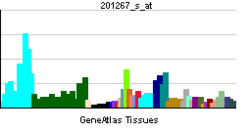PSMC3
26S protease regulatory subunit 6A is an enzyme that in humans is encoded by the PSMC3 gene.[1][2]
Function
The 26S proteasome is a multicatalytic proteinase complex with a highly ordered structure composed of 2 complexes, a 20S core and a 19S regulator. The 20S core is composed of 4 rings of 28 non-identical subunits; 2 rings are composed of 7 alpha subunits and 2 rings are composed of 7 beta subunits. The 19S regulator is composed of a base, which contains 6 ATPase subunits and 2 non-ATPase subunits, and a lid, which contains up to 10 non-ATPase subunits. Proteasomes are distributed throughout eukaryotic cells at a high concentration and cleave peptides in an ATP/ubiquitin-dependent process in a non-lysosomal pathway. An essential function of a modified proteasome, the immunoproteasome, is the processing of class I MHC peptides. This gene encodes one of the ATPase subunits, a member of the triple-A family of ATPases that have chaperone-like activity. This subunit may compete with PSMC2 for binding to the HIV tat protein to regulate the interaction between the viral protein and the transcription complex. A pseudogene has been identified on chromosome 9.[3]
Interactions
PSMC3 has been shown to interact with PSMC5[4] and Von Hippel-Lindau tumor suppressor.[5]
References
- ↑ Hoyle J, Tan KH, Fisher EM (Mar 1997). "Localization of genes encoding two human one-domain members of the AAA family: PSMC5 (the thyroid hormone receptor-interacting protein, TRIP1) and PSMC3 (the Tat-binding protein, TBP1)". Hum Genet 99 (2): 285–8. doi:10.1007/s004390050356. PMID 9048938.
- ↑ Tanahashi N, Suzuki M, Fujiwara T, Takahashi E, Shimbara N, Chung CH et al. (Mar 1998). "Chromosomal localization and immunological analysis of a family of human 26S proteasomal ATPases". Biochem Biophys Res Commun 243 (1): 229–32. doi:10.1006/bbrc.1997.7892. PMID 9473509.
- ↑ "Entrez Gene: PSMC3 proteasome (prosome, macropain) 26S subunit, ATPase, 3".
- ↑ Ishizuka T, Satoh T, Monden T, Shibusawa N, Hashida T, Yamada M et al. (Aug 2001). "Human immunodeficiency virus type 1 Tat binding protein-1 is a transcriptional coactivator specific for TR". Mol. Endocrinol. 15 (8): 1329–43. doi:10.1210/mend.15.8.0680. PMID 11463857.
- ↑ Corn PG, McDonald ER, Herman JG, El-Deiry WS (Nov 2003). "Tat-binding protein-1, a component of the 26S proteasome, contributes to the E3 ubiquitin ligase function of the von Hippel-Lindau protein". Nat. Genet. 35 (3): 229–37. doi:10.1038/ng1254. PMID 14556007.
Further reading
- Coux O, Tanaka K, Goldberg AL (1996). "Structure and functions of the 20S and 26S proteasomes.". Annu. Rev. Biochem. 65: 801–47. doi:10.1146/annurev.bi.65.070196.004101. PMID 8811196.
- Goff SP (2003). "Death by deamination: a novel host restriction system for HIV-1.". Cell 114 (3): 281–3. doi:10.1016/S0092-8674(03)00602-0. PMID 12914693.
- Nelbock P, Dillon PJ, Perkins A, Rosen CA (1990). "A cDNA for a protein that interacts with the human immunodeficiency virus Tat transactivator.". Science 248 (4963): 1650–3. doi:10.1126/science.2194290. PMID 2194290.
- Maruyama K, Sugano S (1994). "Oligo-capping: a simple method to replace the cap structure of eukaryotic mRNAs with oligoribonucleotides.". Gene 138 (1–2): 171–4. doi:10.1016/0378-1119(94)90802-8. PMID 8125298.
- Shaw DR, Ennis HL (1993). "Molecular cloning and developmental regulation of Dictyostelium discoideum homologues of the human and yeast HIV1 Tat-binding protein". Biochem. Biophys. Res. Commun. 193 (3): 1291–6. doi:10.1006/bbrc.1993.1765. PMID 8323548.
- Ohana B, Moore PA, Ruben SM, Southgate CD, Green MR, Rosen CA (1993). "The type 1 human immunodeficiency virus Tat binding protein is a transcriptional activator belonging to an additional family of evolutionarily conserved genes". Proc. Natl. Acad. Sci. U.S.A. 90 (1): 138–42. doi:10.1073/pnas.90.1.138. PMC 45615. PMID 8419915.
- Dubiel W, Ferrell K, Rechsteiner M (1993). "Peptide sequencing identifies MSS1, a modulator of HIV Tat-mediated transactivation, as subunit 7 of the 26 S protease". FEBS Lett. 323 (3): 276–8. doi:10.1016/0014-5793(93)81356-5. PMID 8500623.
- DeMartino GN, Proske RJ, Moomaw CR, Strong AA, Song X, Hisamatsu H et al. (1996). "Identification, purification, and characterization of a PA700-dependent activator of the proteasome". J. Biol. Chem. 271 (6): 3112–8. doi:10.1074/jbc.271.6.3112. PMID 8621709.
- Seeger M, Ferrell K, Frank R, Dubiel W (1997). "HIV-1 tat inhibits the 20 S proteasome and its 11 S regulator-mediated activation". J. Biol. Chem. 272 (13): 8145–8. doi:10.1074/jbc.272.13.8145. PMID 9079628.
- Tanaka T, Nakamura T, Takagi H, Sato M (1997). "Molecular cloning and characterization of a novel TBP-1 interacting protein (TBPIP):enhancement of TBP-1 action on Tat by TBPIP". Biochem. Biophys. Res. Commun. 239 (1): 176–81. doi:10.1006/bbrc.1997.7447. PMID 9345291.
- Suzuki Y, Yoshitomo-Nakagawa K, Maruyama K, Suyama A, Sugano S (1997). "Construction and characterization of a full length-enriched and a 5'-end-enriched cDNA library". Gene 200 (1–2): 149–56. doi:10.1016/S0378-1119(97)00411-3. PMID 9373149.
- Nakamura T, Tanaka T, Takagi H, Sato M (1998). "Cloning and heterogeneous in vivo expression of Tat binding protein-1 (TBP-1) in the mouse". Biochim. Biophys. Acta 1399 (1): 93–100. doi:10.1016/s0167-4781(98)00105-5. PMID 9714759.
- Madani N, Kabat D (1998). "An endogenous inhibitor of human immunodeficiency virus in human lymphocytes is overcome by the viral Vif protein". J. Virol. 72 (12): 10251–5. PMC 110608. PMID 9811770.
- Simon JH, Gaddis NC, Fouchier RA, Malim MH (1998). "Evidence for a newly discovered cellular anti-HIV-1 phenotype". Nat. Med. 4 (12): 1397–400. doi:10.1038/3987. PMID 9846577.
- Park BW, O'Rourke DM, Wang Q, Davis JG, Post A, Qian X et al. (1999). "Induction of the Tat-binding protein 1 gene accompanies the disabling of oncogenic erbB receptor tyrosine kinases". Proc. Natl. Acad. Sci. U.S.A. 96 (11): 6434–8. doi:10.1073/pnas.96.11.6434. PMC 26899. PMID 10339605.
- Tanahashi N, Murakami Y, Minami Y, Shimbara N, Hendil KB, Tanaka K (2000). "Hybrid proteasomes. Induction by interferon-gamma and contribution to ATP-dependent proteolysis". J. Biol. Chem. 275 (19): 14336–45. doi:10.1074/jbc.275.19.14336. PMID 10799514.
- Ijichi H, Tanaka T, Nakamura T, Yagi H, Hakuba A, Sato M (2000). "Molecular cloning and characterization of a human homologue of TBPIP, a BRCA1 locus-related gene". Gene 248 (1–2): 99–107. doi:10.1016/S0378-1119(00)00141-4. PMID 10806355.
